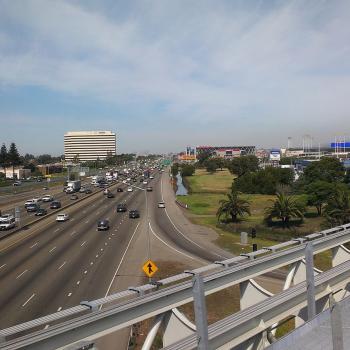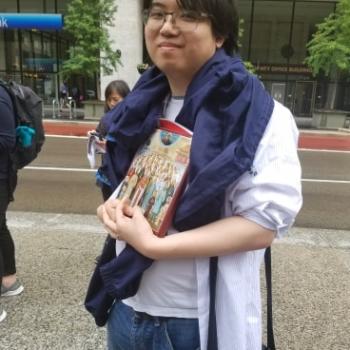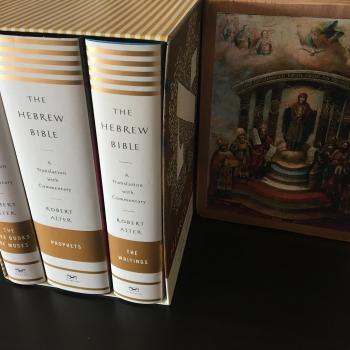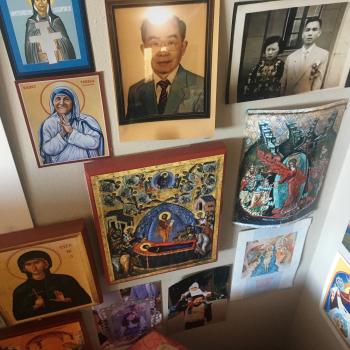qui in ipso paschali festi recursu
fidem sacratæ tibi plebis accendis
auge gratiam quam dedisti,
ut digna omnes intellegentia comprehendant,
quo lavacro abluti, quo Spiritu regenerati,
quo sanguine sunt redempti.
Per Dominum nostrum Iesum Christum Filium tuum,
qui tecum vivit et regnat in unitate Spiritus Sancti, Deus,
per omnia sæcula sæculorum.
Divine Mercy Sunday may well be a salient interpretive lens for post-Vatican II Catholicism.
I realize that by saying that, I am utterly and hopelessly late to the party. I apologize. My graduate work was really supposed to be only about Cantonese-speaking Protestants, first only in Vancouver and then around the Pacific Rim region. It wasn’t until I did more fieldwork in Hong Kong that I realized that Catholic ecumenical partnerships with Protestants made the whole question of Catholicism inescapable. It’s for that reason that I’ve adjusted my postdoctoral project on Asian American Christian publics to include Catholicism. That’s small penance for a lateness that is not even fashionable.
Call me slow, then, but it’s because of my lateness that it didn’t occur to me until yesterday after the canonization of John XIII and John Paul II that I should think much more seriously about Divine Mercy Sunday in relation to the Second Vatican Council. I should have known better. Reading Dives in Misericordia, one gets the sense that John Paul II, who in his previous life as Karol Wojtyła was one of the Vatican II pereti who authored Gaudium et spes, is now providing a close reading of how exactly the church sides with the joys and hopes of the modern world: by being an agent of divine mercy.
As I get my feet wet in Catholic studies, one of the issues by which I’ve been struck is the way that scholars in the field position the two popes who were canonized yesterday as ideologically opposed to each other. To be sure, I was already aware of this divide, as one of the key texts in secularization studies, José Casanova’s Public Religions in the Modern World, is largely premised on the Second Vatican Council being a major force in the deprivatization of modern religions as channels of political and social liberation. Arguing that John XXIII’s aggiornamento ‘officially redefined the self-identity of the Catholic church,’ Casanova sees texts like Gaudium et spes, Dignitatis Humanae, Lumen Gentium, and Christus Dominus as producing ideological struggles within the Catholic Church that have spilled out into other post-1960s religions. In this context, Casanova already hinted to me that John Paul II has been seen as a reactionary to the open-mindedness of John XXIII:
As shown by the ideological struggles taking place within the church since the accession of Karol Wojtyła to the Papacy, and particularly since the accession of Cardinal Ratzinger to the old post of modern “grand inquisitor,” there is much room for disagreement among the relevant collective actors over the correct theological interpretation of those texts. But sociologically speaking, the sociohistorical consequences, intended or unintended, unleashed by the publication and the widespread internalization of the message of these documents are undeniable. There is no better confirmation than the very emergence of a project of Catholic “restoration” based on the premise that these sociohistorical consequences were the unexpected and undesired result of a misinterpretation of the original Vatican intent. (Casanova 1994: 73).
Casanova’s approach is typical. John Paul II and Benedict XVI are argued to be the architects of a Catholic conservatism, closing the doors that John XXIII opened.
Allow me to think out loud after watching yesterday’s double canonization. In the presence of one of these ‘reactionaries’ (Benedict XVI), Pope Francis — himself said to have brought back the openness of John XXIII — canonized John Paul II alongside the pope who was, as Francis put it, ‘open to the Holy Spirit.’ Arguing that both popes embodied the parrhesia that comes from not being ashamed of the ‘wounds of Christ,’ Francis suggested that what tied both men together was their experience of the sufferings of the twentieth century, wounds that were wrought precisely by ideological disregard for the human person. I wonder, then, whether accounts that pit John XXII and John Paul II against each other in fact perform what John Milbank would call ‘epistemic violence’ against how these two popes practiced the spirit of Vatican II. Indeed, as Artur Rosman shows repeatedly on Cosmos the in Lost, the real problem with George Weigel’s supposedly magisterial account of John Paul II is that Weigel ideologizes John Paul II without allowing him to speak as a complex human person.
This is particularly salient when it comes to Asia-Pacific Catholicisms. John Paul II is known to be the more political pope, chanting ‘Solidarity’ with the Polish people to bring down its Communist government and eventually leading the way to the pulling back of the Iron Curtain. Yet at yesterday’s canonization, it was not the spirit of John Paul II that was invoked for Catholic geopolitics. In the prayers of the faithful, the Chinese intercessor asked St. John XXIII to ‘help the leaders of nations, in their thoughts and decisions, to reject every escalation of hatred and violence’ so that ‘all human relations reveal the victory of Jesus risen and live.’ That this prayer was read in Putonghua Chinese should not be overlooked: following the legacies of Chinese bishops like Alphonsus Jin, Ignatius Kung, Jean-Baptist Wu, and Joseph Zen, this is a statement in Sino-Vatican geopolitics that the attempts of the Chinese state to control the consecration of bishops is directly related to its human rights record and bilateral relations with other nation-states. Pushing beyond the accepted wisdom that Asian Catholicisms are about ‘inculturation’ and private familial sociality, the Vatican (as my colleague Jonathan Tan always reminds me) has always known that Asia-Pacific Catholicisms are sites in which the geopolitics of Catholicism are always brought to the fore.
This brings us back to Divine Mercy Sunday. The prayer for Divine Mercy Sunday asks ‘that all may grasp and rightly understand in what font they have been washed, by whose Spirit they have been reborn, by whose Blood they have been redeemed.’ The implication here is that divine mercy is political, that the practice of aggiornamento has geopolitical implications, that being in solidarity with the joys and hopes of the modern world puts Catholic geopolitics as the central ethical implication of Catholic dogma and social teaching. As political geographer John Agnew has written to fellow geographers, the quotidian geopolitics of the Catholic Church should not be overlooked; indeed, in his 2014 lecture for the Geography of Religions and Belief Systems Specialty Group at the Association of American Geographers’ Annual Meeting, he said that even before Vatican II, the political posturing of Pius XI and XII toward Benito Mussolini’s fascist regime resulted in forms of placemaking in the city of Rome that undermined the fascists’ totalitarian aspirations.
What we saw yesterday, then, was nothing short of Francis’s yes to the Divine Mercy geopolitics of Vatican II. It’s for us now to flesh out its on-the-ground implications. I’d be happy to get help as I do so in the Asia-Pacific and Asian North America.











